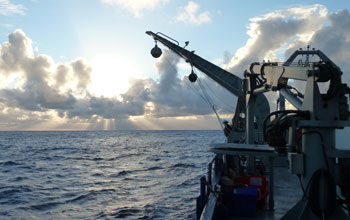Multimedia Gallery
R/V Melville at South Pacific Subtropical Gyre
The South Pacific Subtropical Gyre (26.25°S, 109.96°W) located approximately 500 kilometers east of Isla de Pascua, Chile. Onboard the research vessel (R/V) Melville, scientists from the lab of Sallie (Penny) Chisholm, a professor of environmental studies at the Massachusetts Institute of Technology, examined the biogeography of photosynthetic bacteria and the viruses that infect them. The researchers discovered that certain photosynthetic ocean bacteria contract viruses carrying genetic material taken from their previous bacterial hosts. The virus tricks the new host into using its own machinery to activate the genes, a process never before documented in any virus-bacteria relationship.
The process works like this. When a grifter virus finds a bacterium living in a phosphorus-starved region of the ocean, it injects its DNA into the bacterium. The bacteria are stressed by the lack of phosphorus, which they use as a nutrient. The virus senses the host's stress and offers what seems like a helping hand: Bacterial genes nearly identical to the host's own that enable the host to gather more phosphorus. The host uses the genes, but the additional phosphorus goes primarily toward supporting the virus' replication of its own DNA. Once that process is complete (about 10 hours after infection), the virus explodes its host, releasing progeny viruses back into the ocean, where they can invade other bacteria and repeat the process. The additional phosphorus-gathering genes provided by the virus keep its reproduction cycle on schedule.
This research was supported in part by awards to Sallie W. Chisholm from the National Science Foundation (NSF) Center for Microbial Oceanography: Research and Education and the NSF Biological Oceanography Program. The expedition was funded by the NSF-supported Center for Microbial Oceanography: Research and Education, an NSF Science and Technology Center.
To learn more about this discovery, see the MIT news story Viruses con bacteria into working for them. (Date of Image: December 2010)
Credit: Paul M. Berube, Department of Civil and Environmental Engineering, Massachusetts Institute of Technology
See other images like this on your iPhone or iPad download NSF Science Zone on the Apple App Store.
Images and other media in the National Science Foundation Multimedia Gallery are available for use in print and electronic material by NSF employees, members of the media, university staff, teachers and the general public. All media in the gallery are intended for personal, educational and nonprofit/non-commercial use only.
Images credited to the National Science Foundation, a federal agency, are in the public domain. The images were created by employees of the United States Government as part of their official duties or prepared by contractors as "works for hire" for NSF. You may freely use NSF-credited images and, at your discretion, credit NSF with a "Courtesy: National Science Foundation" notation.
Additional information about general usage can be found in Conditions.
Also Available:
Download the high-resolution JPG version of the image. (4.9 MB)
Use your mouse to right-click (Mac users may need to Ctrl-click) the link above and choose the option that will save the file or target to your computer.



